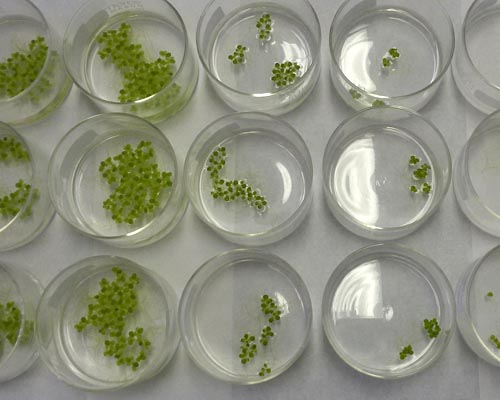OECD TG 221: Lemna sp. Growth Inhibition test
Lemna sp. aquatic plants (in house breeding at B.T.) are exposed to a range of concentrations of the test substance in test medium, for 7 days in a static or semi-static system to evaluate the growth rate inhibtion or yield inhibition.
TEST SYSTEM
Lemna minor (SIS medium), Lemna gibba (AAP 20X) medium.
A toxic reference substance is tested twice a year to check the sensitivity of the organisms.

STUDY DESIGN
Range finding test includes at least 5 concentrations of the test substance and 1 untreated control (3 replicates/concentration or control) with plants with a total of 9 to 12 fronds/replicate
Limit test is carried out with 1 concentration (100 mg/L or at solubility limit) of the test substance and 1 untreated control (at least 6 replicates/concentration or control) with plants with a total of 9 to 12 fronds/replicate
Dose-response test includes at least 5 concentrations of the test substance and
1 untreated control (3 replicates/concentration or control) with plants with a total of 9 to 12 fronds/replicate.
Analytical checks, to verify the exposure concentrations in the medium, are performed for static test at time 0 and at time 7 days on control and on each test substance sample and for semi-static test at time 0, at 2 days, at 5 days and at 7 days on control and on each test substance sample.
The analysis are performed using a method validated according to SANCO/825/00 rev. 8.1 and SANCO/3029/99 rev. 4 guidance documents.
ENDPOINTS
Inhibition of the growth rate and of the yield: EC10, EC20, EC50, NOEC/LOEC after 7 days calculated by the fronds number. Dry or fresh weight.
Study includes GLP management and reporting.
REFERENCES AND GUIDELINES
OECD Guideline fo Testing of Chemicals, No. 221 (23rd March 2006) – Lemna sp. growth inhibition test.
OECD Series on Pesticides, Number 67: “OECD guidance to the environmental safety evaluation of microbial biocontrol agents” (17th February 2012).
Environmental Canada, EPS 1/RM/44: “Guidance Document for Testing the Pathogenicity and Toxicity of New Microbial Substances to Aquatic and Terrestrial Organisms” (March 2004).
SANCO/825/00 rev. 8.1 (16/11/2010) – Guidance document on pesticide residue analytical methods.
SANCO/3029/99 rev. 4 (11/07/2000) – Residues: guidance for generating and reporting methods of analysis in support of pre-registration data requirements for Annex II (Part A, section 4) and Annex III (Part A, section 5) of Directive 91/414.
Study finder
Scientific Contact
Sabrina Mantilacci
E-mail: mantilacci@biotecnologiebt.it
Phone: +39 075 895 0045 – Ext. 268
Business Contact
Katy Lazzari
E-mail: klazzari@biotecnologiebt.it
Phone: +39 075 895 0045 – Ext. 246
Need more info? Send us a message
Fill in the form with the required information (*).
Our team will be happy to provide all the necessary support with regard to your request.


 English
English Italian
Italian